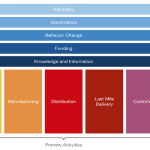Can Pay-As-You-Go Help Clean Up Clean Cooking?
Over the past few decades, energy access discourse and practice have been dominated by electrification efforts. This started to change with the launch of the Sustainable Development Goals in 2015, which included a specific target for clean cooking under the seventh goal of universal access to clean, affordable energy. This broader focus was welcome, as traditional biomass-based cooking practices present major health and safety risks to people (particularly women and children) while also harming the environment. At the household level, cooking with clean fuels reduces acute health symptoms, lowers the risk of cancer and saves time that can be used for other productive activities. At the population level, this translates into substantial positive health, environmental and gender impacts.
Since 2015, the global focus on clean cooking has grown substantially, with larger amounts of funding flowing into the sector, heightened attention from policymakers, and significant investments in research (e.g., the CLEAN-Air(Africa) and MECS programmes). But progress remains slow, especially in sub-Saharan Africa, where the number of people without access to clean cooking is growing year on year. This is partially because access to clean cooking is growing at a slower rate than the region’s population. However, it’s also due to the ineffectiveness of clean cooking initiatives to date. This article examines some of the reasons behind the inertia that is plaguing clean cooking access, and explores whether pay-as-you-go (PAYG) business models could catalyse progress.
The quest for the unicorn stove
Efforts to promote clean cooking date back to the 1980s, and were initially focused on designing and distributing various iterations of improved cook stoves (ICS). These stoves aim to burn woodfuels (usually firewood or charcoal) more efficiently than their traditional counterparts, thus saving fuel and reducing emissions.
However, the field performance of ICS was often significantly poorer than their corresponding lab tests suggested, so they failed to mitigate the negative health and climatic impacts that motivated their distribution in the first place. All too often the stoves in question were designed by Western engineers who did not prioritise the needs of the end user: the millions of rural women who cook for their families and communities on a daily basis. This resulted in low levels of adoption and further hindered the stoves’ ability to achieve their intended impacts.
The failure to convert input dollars into output impact left investors bruised, and the sector lost credibility among global development funders. Although ICS technologies have since improved, there is now a debate over whether it is appropriate to promote technologies that burn biomass at all. Instead, many practitioners and researchers are calling for a shift in strategy to increase the availability of non-polluting, modern fuels like liquefied petroleum gas (LPG) and electricity.
The challenge of making clean cookstoves available
Further complicating this debate, transitioning populations to clean fuels is enormously challenging for the following reasons:
- Affordability: Clean fuels tend to cost more than polluting alternatives, which often have zero monetary cost in areas where firewood can be gathered for free. On top of this, switching fuel also requires people to incur the up-front cost of purchasing new equipment. And LPG — the most commonly used clean fuel in developing world settings — almost always needs to be purchased in bulk, which can be incompatible with the day-to-day expenditures of poor people.
- Availability: Making clean cookstoves available requires alternative fuels to be supplied to communities. This raises multiple supply challenges, which can be particularly difficult to overcome in remote areas.
- Sustained adoption: Clean stoves are often used as ancillary devices that supplement traditional fuels. Research has shown that anything short of exclusive use negates most of the health and environmental gains of clean cooking. Changing this behaviour is a complex process that involves altering cultural practices and acquiring new skills.
These barriers must be overcome in order to make cooking with clean fuels viable at scale. Some countries (e.g., Indonesia, India and Peru) have addressed them through policies that subsidise LPG equipment and fuel. However, such programmes are expensive and unlikely to be financially viable in many markets, including much of sub-Saharan Africa.
The emergence of pay-as-you-go clean cooking business models
Some promising solutions are emerging in response to these challenges. Inspired by the solar sector, the past few years have seen a number of PAYG cooking providers enter the market. These companies supply a range of clean fuels, such as KOKO Networks with ethanol, Circle Gas, Bboxx and PayGo Energy with LPG, BioMassters with biomass pellets, and ATEC with a range of electrical devices. Their underlying business models are broadly similar and rely on new innovations (e.g., PAYG smart meters for LPG) that allow customers to buy fuel in small quantities, thereby matching the purchasing patterns of polluting alternatives. Payments are made via mobile money to maximise convenience, and the upfront cost of the stove is often either included in the fuel price charged to consumers, or subsidised by carbon credits that the business sells to external funders.
Companies that use the PAYG model typically provide warranties to ensure the long-term functionality of their equipment, and they often deliver fuel replenishments directly to households. PAYG thus helps low-income households to transition to clean cooking by:
- Reducing the minimum transaction size for purchasing fuel;
- Increasing the up-front affordability of clean cooking; and
- Solving availability issues by placing the onus on the provider to ensure fuel availability and equipment functionality.
PAYG models are intrinsically customer-centric, as their revenue is derived from ongoing fuel sales paid for by the user rather than one-off purchases that leave the provider with no understanding about how (or whether) the product was used. These fuel sales create large, granular data sets containing detailed insights about technology use. This allows providers to track customer adoption, with two important consequences: 1) they are able to identify customers with low levels of adoption and are financially incentivised to drive higher levels of clean fuel use among these customers; and 2) they can more accurately verify and monetise the impacts their stoves are making (e.g., through carbon credits or results-based financing schemes).
However, these added benefits come at a cost. Providers may need to add high margins to cover the additional technology and services that are needed to enable the PAYG functionality. This is certainly the case with PAYG LPG, which can be 1.7 times more expensive than standard full-cylinder LPG on a per kg basis. Also, PAYG business models are inherently difficult to make work; they require high levels of scale to compensate for their low profit margins, and often involve financing expensive equipment, which necessitates large sources of capital.
The outlook for PAYG in clean cooking
What little research has been conducted so far shows that PAYG technologies can unlock clean cooking for populations that are otherwise unable to afford it. Yet these business models are challenging and capital-intensive, as has been demonstrated by a number of high-profile liquidations or product withdrawals (e.g., Inyenyeri). However, there are some success stories emerging from companies that have now reached noteworthy levels of scale in urban areas (e.g., Circle Gas and KOKO Networks), often with heavy support from carbon credits.
But despite this progress, it is also important to acknowledge that PAYG is no silver bullet. Although these models are theoretically highly scalable, their overall market penetration remains negligible. PAYG-enabled clean cooking products are likely to remain unaffordable for the very bottom of the pyramid, and PAYG companies have yet to conquer any rural markets. Further support from governments and donors may be required for these businesses to achieve exponential scale, whether in the form of subsidies, tax exemptions or other incentives.
To summarise, PAYG cooking products can increase the affordability and accessibility of clean fuels, while placing customer satisfaction at the heart of these companies’ operations. PAYG therefore addresses many of the challenges that have historically limited the clean cooking sector. However, these business models bring additional complexities that may hinder their growth. More research is needed to understand the true impacts of PAYG business models, how they can reach profitability and scale, and how the rapidly developing landscape of support mechanisms for the clean cooking sector — such as results-based financing initiatives, carbon credits and targeted subsidies — can enable them to reach their full potential.
Tash Perros is a Post-Doctoral Research Associate at the University of Liverpool; Iwona Bisaga is an independent energy access consultant, an Honorary Lecturer at University College London and a Visiting Fellow at Loughborough University; Julia Tomei is an Associate Professor at the UCL Institute for Sustainable Resources (ISR).
Photo courtesy of rhodesj.
- Categories
- Energy, Environment, Technology



